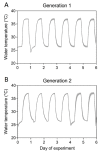Cross-Generational Effects of Heat Stress on Fitness and Wolbachia Density in Aedes aegypti Mosquitoes
- PMID: 30642130
- PMCID: PMC6473245
- DOI: 10.3390/tropicalmed4010013
Cross-Generational Effects of Heat Stress on Fitness and Wolbachia Density in Aedes aegypti Mosquitoes
Abstract
Aedes aegypti mosquitoes infected with Wolbachia symbionts are now being released into the field to control the spread of pathogenic human arboviruses. Wolbachia can spread throughout vector populations by inducing cytoplasmic incompatibility and can reduce disease transmission by interfering with virus replication. The success of this strategy depends on the effects of Wolbachia on mosquito fitness and the stability of Wolbachia infections across generations. Wolbachia infections are vulnerable to heat stress, and sustained periods of hot weather in the field may influence their utility as disease control agents, particularly if temperature effects persist across generations. To investigate the cross-generational effects of heat stress on Wolbachia density and mosquito fitness, we subjected Ae. aegypti with two different Wolbachia infection types (wMel, wAlbB) and uninfected controls to cyclical heat stress during larval development over two generations. We then tested adult starvation tolerance and wing length as measures of fitness and measured the density of wMel in adults. Both heat stress and Wolbachia infection reduced adult starvation tolerance. wMel Wolbachia density in female offspring was lower when mothers experienced heat stress, but male Wolbachia density did not depend on the rearing temperature of the previous generation. We also found cross-generational effects of heat stress on female starvation tolerance, but there was no cross-generational effect on wing length. Fitness costs of Wolbachia infections and cross-generational effects of heat stress on Wolbachia density may reduce the ability of Wolbachia to invade populations and control arbovirus transmission under specific environmental conditions.
Keywords: Aedes aegypti; Wolbachia; cross-generational effects; fitness; heat stress; starvation tolerance.
Conflict of interest statement
The authors declare no conflict of interest.
Figures






References
-
- Loroño-Pino M.A., Cropp C.B., Farfán J.A., Vorndam A.V., Rodríguez-Angulo E.M., Rosado-Paredes E.P., Flores-Flores L.F., Beaty B.J., Gubler D.J. Common occurrence of concurrent infections by multiple dengue virus serotypes. Am. J. Trop. Med. Hyg. 1999;61:725–730. doi: 10.4269/ajtmh.1999.61.725. - DOI - PubMed
Grants and funding
LinkOut - more resources
Full Text Sources

